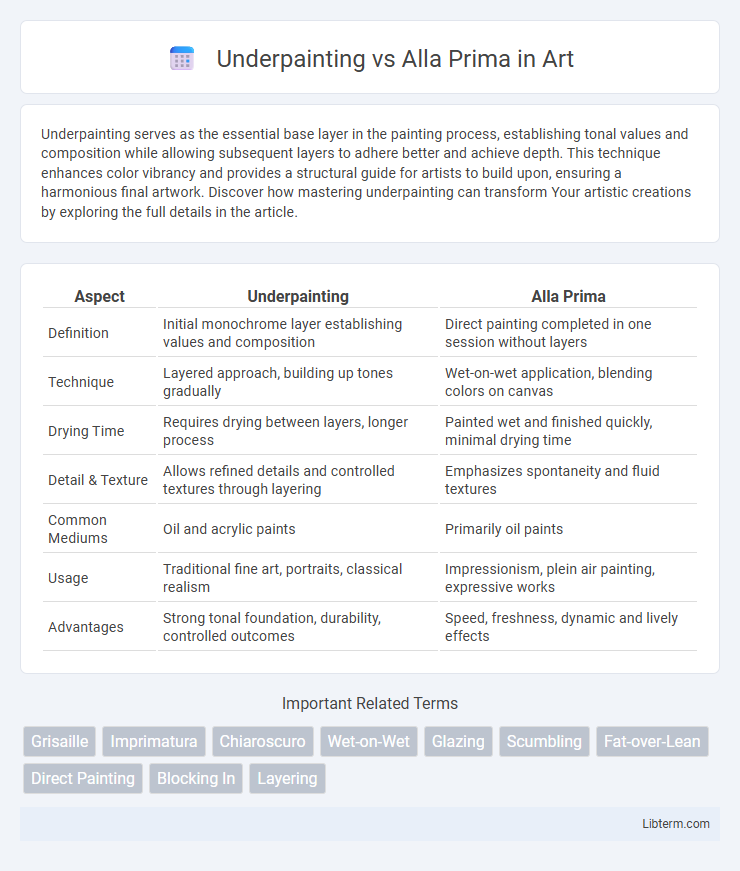Underpainting serves as the essential base layer in the painting process, establishing tonal values and composition while allowing subsequent layers to adhere better and achieve depth. This technique enhances color vibrancy and provides a structural guide for artists to build upon, ensuring a harmonious final artwork. Discover how mastering underpainting can transform Your artistic creations by exploring the full details in the article.
Table of Comparison
| Aspect | Underpainting | Alla Prima |
|---|---|---|
| Definition | Initial monochrome layer establishing values and composition | Direct painting completed in one session without layers |
| Technique | Layered approach, building up tones gradually | Wet-on-wet application, blending colors on canvas |
| Drying Time | Requires drying between layers, longer process | Painted wet and finished quickly, minimal drying time |
| Detail & Texture | Allows refined details and controlled textures through layering | Emphasizes spontaneity and fluid textures |
| Common Mediums | Oil and acrylic paints | Primarily oil paints |
| Usage | Traditional fine art, portraits, classical realism | Impressionism, plein air painting, expressive works |
| Advantages | Strong tonal foundation, durability, controlled outcomes | Speed, freshness, dynamic and lively effects |
Understanding Underpainting: The Foundation of Layers
Underpainting serves as the foundational layer in traditional oil painting techniques, establishing tonal values and composition before applying subsequent layers. This initial monochromatic or simplified color layer enhances depth and luminosity by guiding the placement of highlights and shadows. Mastering underpainting techniques is essential for artists aiming to achieve rich, textured finishes distinct from the direct approach of Alla Prima.
Alla Prima Explained: Painting Wet-on-Wet
Alla Prima, also known as wet-on-wet painting, involves applying fresh layers of paint directly onto still-wet layers, allowing for seamless blending and vibrant color transitions. This technique demands efficient brushwork and quick decision-making to capture light and form before the paint dries. Commonly used in oil painting, Alla Prima enables artists to complete works rapidly, often in a single session, contrasting with traditional underpainting methods that build depth through multiple dry layers.
Historical Origins of Underpainting
Underpainting, rooted in Renaissance art techniques, originated as a monochromatic base layer to establish tonal values and composition before applying color. This method was widely used by Old Masters like Leonardo da Vinci and Titian to create depth and structure in their paintings. In contrast, alla prima, emerging later in the 19th century, involves painting directly with wet paint without an underlayer, emphasizing spontaneity and immediacy.
The Evolution of Alla Prima Technique
The evolution of the alla prima technique marks a significant shift in painting methods, emphasizing wet-on-wet application to complete works in a single session, contrasting with the layered approach of underpainting. Originating in the Renaissance and popularized by artists like John Singer Sargent, alla prima allows for vibrant color blending and spontaneity, reflecting a dynamic interaction between artist and medium. This method revolutionized plein air painting and modern impressionism by enabling faster execution and capturing immediate light effects, expanding artistic expression beyond the constraints of traditional underpainting layers.
Materials Required for Each Approach
Underpainting requires materials such as gessoed canvases or panels, oil or acrylic paints thinned with mediums like linseed oil or turpentine, and brushes suitable for creating detailed base layers. Alla prima painting demands high-quality, fast-drying oil paints or acrylics, a palette with limited color selection for wet-on-wet blending, and a variety of brushes to achieve direct, expressive strokes in a single session. Both techniques benefit from using primed surfaces but differ in the layering and drying time considerations tied to their respective materials.
Workflow Differences: Step-by-Step Comparison
Underpainting involves creating an initial monochromatic layer to establish composition, values, and tonal range before applying multiple layers of color, allowing for gradual refinement and depth. Alla Prima is a wet-on-wet technique where paints are applied directly in one session without drying time, encouraging spontaneity and blending on the canvas. The step-by-step workflow in underpainting requires drying periods between layers, whereas alla prima demands swift execution and decisive brushwork to complete the artwork in a single sitting.
Advantages and Challenges of Underpainting
Underpainting provides a strong tonal foundation that enhances depth and composition control, allowing artists to establish values and shapes before applying final colors. Its advantage lies in improved paint adhesion and longevity, but challenges include longer drying periods and potential overworking if layers are not properly managed. Mastery of underpainting techniques demands patience and skill to balance initial sketches with subsequent color application effectively.
Benefits and Drawbacks of Alla Prima
Alla Prima painting allows artists to complete works in a single session, promoting spontaneity and fresh color blending, ideal for capturing immediate impressions. However, this technique demands speed and precision, which can challenge beginners and limit opportunities for detailed adjustments or layering effects. The fast-drying nature of wet-on-wet paints in Alla Prima may also increase the risk of muddy colors without careful control.
Ideal Subjects for Each Painting Method
Underpainting suits complex compositions requiring detailed layering and tonal depth, such as portraits and landscapes needing gradual color buildup and refinement. Alla prima excels with lively, spontaneous subjects like plein air scenes and quick studies where fresh, wet-on-wet application captures dynamic light and immediate expression. Selecting between these methods depends on the artist's goal to convey either meticulous detail or vivid, direct impressions.
Choosing Between Underpainting and Alla Prima: Artistic Intent
Choosing between underpainting and alla prima techniques depends largely on the artist's creative objectives and desired finishing texture. Underpainting allows layering and refining details, ideal for works requiring depth and gradual tonal development. Alla prima suits spontaneous expression and vibrant immediacy, enabling completion in one session with wet-on-wet paint application.
Underpainting Infographic

 libterm.com
libterm.com